|
Continuous development effort brought some innovations to the
series of G2 CCD cameras. Innovations cover camera mechanics,
electronics and also software.

G2 CCD camera—top quality
scientific-grade instrument More efficient CCD chip cooling up to -50°C below
ambient
Updated G2 CCD cameras use magnetic-levitating fans instead of
ball-bearing fans, used in the previous revisions.
Magnetic-levitating fans are quieter and do not slow down at
below-freezing temperatures. Also their durability is much
higher.
But more important enhancement is redesigned heat sink and air
flow vents. New heat sink has more fins and individual fins have
better shaped, so the heat is more efficiently removed from the
Peltier cooler hot side. Also air vents on the camera head are
optimized to allow hot air escape the camera head as quickly as
possible. New cameras can achieve up to 45 °C temperature drop below ambient temperature
with air cooling and regulation working.
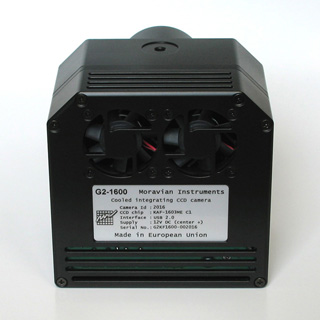
Optimized air vents on the G2 CCD camera head Air input vents are also differently shaped. They provide less
air flow resistance and quieter operation, eliminating aerodynamic
shocks. This makes the new version of G2 camera significantly
quieter.
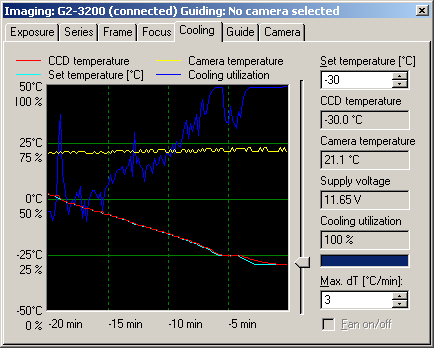
Maximum temperature drop -50°C provides little room for
regulation 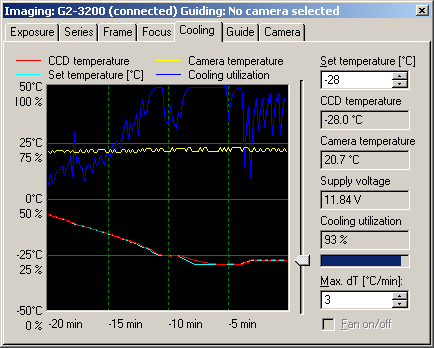
Temperature drop -48°C can be achieved wit approx. 90%
of cooling power The environment thermometer was moved to different place so it
is less affected by the Peltier hot side. The temperature it shows
reflects the ambient air temperature more precisely and with less
waves.
Faster download
G2 camera firmware was recently updated to provide very smooth
frames, without any trace of irregularities caused by CCD
clocking. Such irregularities occurred in the first models of G2
cameras, and although they were well below read noise (typically
around 3 e- for the 15 e- read noise), they started to be observable
after stacking many tens of individual frames without mutual
shifting. The minus side was the firmware update eliminating these
artifacts caused around 10% slowdown of frame read.
Enhanced digital electronics of the new revision of G2 cameras
provide average speedup around 10% for standard read modes and 20%
for low noise read modes. This effectively eliminates the slowdown
caused by the enhanced firmware for standard read modes and brings
approx. 10% resulting speedup for low noise read modes. The
download times for individual cameras are summarized in the
following table.
| Camera |
Read Mode |
Download time (original) |
Download time (new) |
Speedup |
| G2-0402 |
Standard read |
1.20 s |
1.08 s |
11 % |
| |
ULN read |
1.50 s |
1.27 s |
18 % |
| G2-1600 |
Standard read |
4.50 s |
4.09 s |
10 % |
| |
ULN read |
6.00 s |
4.90 s |
22 % |
| G2-3200 |
Standard read |
9.70 s |
8.60 s |
13 % |
| |
ULN read |
12.60 s |
10.30 s |
22 % |
More light-tight shutter, minimized internal
reflections
The whole CCD cold chamber light entrance was redesigned. The
new light entrance eliminates vignetting of large chips,
especially when used with fast optical systems. Artifacts caused
by reflections, when some bright star was projected just to the
border of light entrance, was also eliminated. New shutter
provides much better shielding—it allows
acquiring of dark frames during dawn or at twilight, it is no
longer necessary to wait for dark.
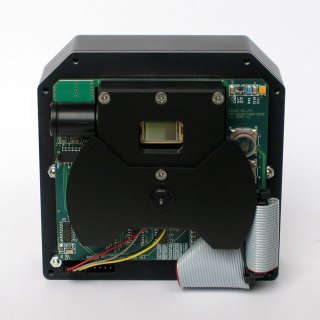
CCD chip cold chamber with shutter open Tripod-bolt mounting thread
The camera head was equipped with a threaded hole for standard
tripod bolt (0.25-20 UNC thread). Although the
camera is attached to the telescope focuser in majority of
applications, sometimes it is used with photographic lens and
needs to be attached to tripod or some mounting plate. The
standard thread provides the more convenient way to do it.
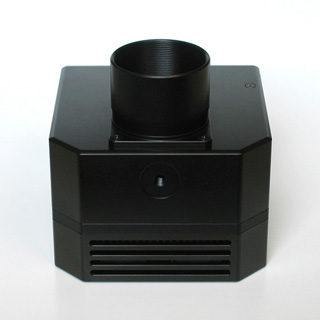
Tripod bolt thread on the top of the G2 camera
head Guiding
Well, guiding of the G2 camera with a standalone G1 guider is
not a new feature of G2 camera itself. G1 guider can be definitely
used to guide any CCD camera or DSLR on any mount equipped with
standard Autoguider port. But both series of G2 and G1 cameras
were designed to complement themselves, to be easily used as
imaging/guiding pair. Advanced features, required for serious
imaging and scientific work, were implemented in G2 series of
cameras. G1 guiders on the other side do not provide active
cooling, mechanical shutter or filter wheel. But they are
optimized for simple operation (you need just single USB cable to
operate G1 camera), they are light and small enough to be
connected to any guider telescope, robust enough to provide
thousands of guider images per main camera exposure and sensible
enough to ensure reliable guiding even if only dim stars are
available for guiding.
G2 scientific grade CCD camera and G1 guiding/imaging
CCD camera | 